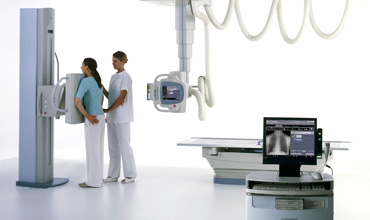Iodinated Contrast Media: Adverse Reactions in Radiography practice

Abstract:
This
is an article review based on a research work on ‘Adverse reactions to
iodinated contrast media, prevalence, risk factors and outcome – the results of
a 3-year period’ by Panitan, et al., published in the Asian Pac J Allergy
Immunology; April 31 2013: 299 – 306. http://apjai.digitaljournals.org. The
review will comprise a brief summary of the article and a critical analysis of
the structure. The article’s general content and scope will also be assessed
for currency and relevance. The article’s authority on the issues discussed and
credibility in view of current knowledge will also be evaluated.
References:
[1]. American
College of Radiology (ACR): (2010)
Manual on contrast media, Version 7.
[2]. Cochran ST,
Bomyea K, Sayre JW (2001) Trends in adverse events after IV administration of
contrast media. AJR AM J Roentgenol; 176: 1385-1388
[3]. Dawson P
(1987) Iodinated intravascular contrast agents: A review. J Intervent Radio;
2:51
[4]. Dickson
M.C. and Kam P.C.A. (2008) Intravascular Iodinated Contrast Media and the
Anesthetist, Journal of Anesthesia, Vol 63 (6); 626-634
[5]. Entricht T,
Chau-Lim, Duda E et al (1989) The role of a documented allergic profile as a
risk factor for radiographic contrast-media reaction. Ann Allergy. 62: 302-305.
[6]. Fischer HW
(1986) Catalog of intravascular contrast media. Radiology, 159: 561.
[7]. Greenberger
PA, Patterson R (1991) The prevention of immediate generalized reaction to
radio contrast media in high-risk patients, J Allergy Clin Immunol. 87:867-872
[8]. Greenberger
P, Meyers S, Kramer B (1987) Effect of beta-adrenergic and calcium antagonists
on the development of anaphylactoid reactions from radiographic contrast media
during cardiac angiography. J Allergy Clin Immunol. 80; 698-702.
[9]. Katayama H,
Yamaguchi K, Kozuka T, et al (1990) Adverse reactions to ionic and nonionic
contrast media; a report from the Japanese committee on the safety of contrast
media Radiology; 175: 621-628. 2010
[10]. Land D
Allpern M, Visintainer P, Smiths (1991) increased risk for anaphylactoid
reaction from contrast media in patients on beta adrenergic blockers or with
asthma Ann intern med; 115,270,276.
[11]. Land DM,
Alpern MB, Visintainer PF et al (1995) Gender risk for anaphylactoid reaction
to radiographic contrast media. J Allergy Clin Immunology; 95: 813-817.
[12]. Lasser EC,
Berry CC, Mishkin MM et al (1994) Pre-treatment with steroids to prevent
reactions to non ionic contrast media. AJR Am J Roentgenol. 162: 523-526.
[13]. Manouchehr
S (2012) Intravenous Radio-contrast media; A review of Allergic Reactions. US
Pharmacist, 37 (5); Hs 14 – Hs 16 (5) 22/2012
[14]. Marshall
GD, Lieberman PL (1991) Comparison of three pretreatment protocols to prevent
anaphylactoid reactions to radio contrast media. Ann Allergy 67: 70-74.
[15]. Mueller C.
(2006) Prevention of contrast-induced nephropathy with volume supplementation. Kidney
Int suppl, 100: 516-19.
[16]. NICE
Clinical guide 134 (2011), Anaplylaxis. Assessment: to confirm an anaphylactic
episode and the decision to refer after emergency treatment for a suspected
anaphylactic episode. National institute for Health and Clinical excellence,
Guide 134. http://www.nice org.uk/guidance/CG134
[17]. Rao AK,
Thompson R, Durlacher L et al (1985) Angiographic contrast agent-induced acute
haemolysis in a patient with hemoglobin SC disease. Arch Intern Med; 145; 759.
[18]. Rudnick
MR, Berns JS, Cohen RM, Goldfarb S (1994) Nephrotoxic risk of renal
angiography; contrast-media associated nephrotoxicity and atheroembolism – a
critical review. AM J Kidney Dis; 24; 713-727.
[19]. Schatz M,
Patterson R, O’Rourke J et al (1975) The administration of radiographic
contrast media to patients with history of previous reactions. J Allergy Clin
Immunol. 55: 358-366.
[20]. Solensky R
& Khan David A (2010) Drug Allergy: An updated practice parameters
(developed by the joint task force on practice parameters representing the
American Academy of Allergy, Asthma and immunology, and the joint council of
Allergy, Asthma and Immunology; Vol. 105; 275-78.
[21]. Swanson D
(1988) Conventional or low-osmolality: picking the right contrast media. Diagnostic
Imaging, 10: 191.
[22]. Thrall J
(1990) Adverse reactions to contract media; etiology, incidence, treatment,
prevention, Inswanson DP Chilton HM, Thrall JH eds. Pharmaceuticals in medical
imaging. New York; Macmillan. 253-2277.
[23]. Wang CL,
Cohan RH, Ellis JH, Caoili EM, Wangt Francis IR (2008) Frequency, outcome and
appropriateness of treatment of nonionic iodinated contrast media reactions.
AJR Am J Roentgenol, 191: 409-415 Wolfal, Mishkin MM, Rour SG, et al (1991)
Comparison of the rates of adverse drug reactions; ionic contrast agents; ionic
agents combined with steroids and nonionic contrast agents. Invest Radiol; 26:
404-410

